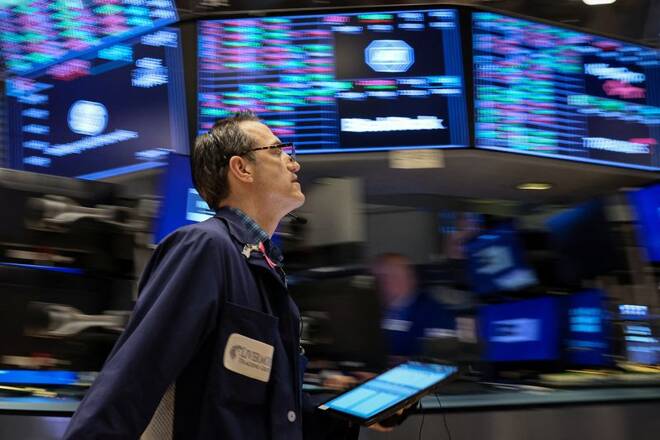Advertisement
Advertisement
Column-Clock ticks on lofty U.S. stocks: McGeever
By:
By Jamie McGeever ORLANDO, Fla. (Reuters) - To paraphrase John Maynard Keynes's apocryphal quote, stock markets are staying over-valued longer than investors are staying rational, but the relentless rise in bond yields and interest rates should soon change that.
By Jamie McGeever
ORLANDO, Fla. (Reuters) – To paraphrase John Maynard Keynes’s apocryphal quote, stock markets are staying over-valued longer than investors are staying rational, but the relentless rise in bond yields and interest rates should soon change that.
Analysts agree that U.S. equity valuations are expensive, nominally and relative to history and overseas peers. The only real debate over the coming correction is its timing and scale, even if U.S. stocks still end the year higher.
Post-pandemic economic and market conditions are completely unique, so the past may not be as reliable a guide to the future. But history, market models and the laws of gravity are all pointing in the same direction.
Bond yields are now so high that stocks are the least attractive to bonds in two decades, while the outlook for valuations and earnings has still not been lowered as far as the unprecedented surge in interest rates would warrant.
S&P 500 earnings yield vs 2-year Treasury yield https://fingfx.thomsonreuters.com/gfx/mkt/lgpdkojawvo/US2YSNP500.jpg
Benson Durham, head of global asset allocation at Piper Sandler, runs about 10 million models to garner fair-value equity estimates for 11 developed economies. Around 9.4 million imply U.S. over-valuation, around 700,000 imply under-valuation.
Taken together they suggest U.S. stocks are 13% over-valued, the third most expensive behind France and New Zealand, and significantly richer than Japan and Germany, where stocks are 3% and 1% over-valued, respectively.
Although earnings expectations have come down and investors can earn 5% just sticking their cash in ‘risk-free’ U.S. government bills, Wall Street hasn’t yet buckled.
The S&P 500 is still up 3.5% this year, the Nasdaq up 10%, and the S&P 500 price-to-earnings ratio comfortably above historical averages and current international comparisons.
“Stocks should be coming down but they’re not, so it is a bit of a puzzle,” Durham said. “The equity market is buying into a pretty rosy outlook, the ‘immaculate disinflation’ concept. Investors may be in for a shock.”
US vs global forward PE ratios https://fingfx.thomsonreuters.com/gfx/mkt/jnpwyajldpw/GLOBALPE.jpg
Irrationality?
By many metrics, stocks right now shouldn’t be worth the risk. The two-year Treasury yield is on a par with the S&P 500 earnings yield for the first time in over 20 years, and six-month bills are an even more attractive investment with a yield north of 5.0%.
The S&P 500 is currently trading at around 18.5 times 12-month forward earnings. That is comfortably above 10-, 20- and 30-year averages, and significantly more expensive than international peers.
S&P 500 forward PE ratio vs historical averages https://fingfx.thomsonreuters.com/gfx/mkt/mypmoabjjpr/USPERATIO.jpg
Keith Lerner, co-chief investment officer at Truist, points out that stocks have only sustained higher valuations twice in the past 30 years – during the tech bubble and more recently during the pandemic overshoot.
There’s no suggestion a tech bubble-style crash is coming but whichever way you cut it, Wall Street will struggle to defy gravity for much longer – sticky inflation and a resilient economy keeps Fed policy tighter, which will weigh on market valuations; or the economy weakens and profits suffer.
“Neither of these outcomes are favorable for premium market valuations,” Lerner wrote in a note on Monday.
The jaw-dropping change in the U.S. interest rate landscape bears repeating. On Dec. 31 last year the implied peak Fed rate in mid-2023 was 5.0% and the end-2023 implied rate was 4.50% – they are now almost 50 and 80 basis points higher, respectively.
Yet stocks have dug in, perhaps because investors are betting that higher growth and inflation are here to stay, so the neutral level of real interest rates – so-called R* – should also be higher.
Much will depend on whether the U.S. economy avoids recession, and if not, how severe the downturn is. The so-called ‘no landing’ scenario has gathered momentum recently, but are we to believe that economic cycles no longer exist?
More likely is a hard or soft landing, both of which could be ominous for stocks.
Like many, Barclays U.S. equity analysts’ base case scenario is for a shallow recession. Even that will push the S&P 500’s full-year 2023 earnings per share down around 10% to $200, implying a decline of around 6% for the index.
S&P 500 earnings per share estimates – Barclays https://fingfx.thomsonreuters.com/gfx/mkt/akpeqoenbpr/EPSBARCLAYS.png
In their bear case scenario – a “normal” recession – EPS falls 14% to $190, and the index slumps more than 18% to 3230 by the end of the year.
“Downside to forward earnings raises the risk that equity valuations remain overly optimistic … particularly in the face of a more challenging environment for risk assets,” they wrote on Monday.
To paraphrase another famous 20th century economist, a degree of irrational exuberance appears to have unduly escalated values on Wall Street. But not for much longer.
(The opinions expressed here are those of the author, a columnist for Reuters.)
Related columns:
– Markets ride $1 trillion global liquidity wave
– Faced down by Fed, markets dab 6% onto risk radar
– Stocks find rare resilience to soaring rates
(By Jamie McGeever; Editing by Andrea Ricci)
About the Author
Reuterscontributor
Reuters, the news and media division of Thomson Reuters, is the world’s largest international multimedia news provider reaching more than one billion people every day. Reuters provides trusted business, financial, national, and international news to professionals via Thomson Reuters desktops, the world's media organizations, and directly to consumers at Reuters.com and via Reuters TV. Learn more about Thomson Reuters products:
Did you find this article useful?
Latest news and analysis
Advertisement
